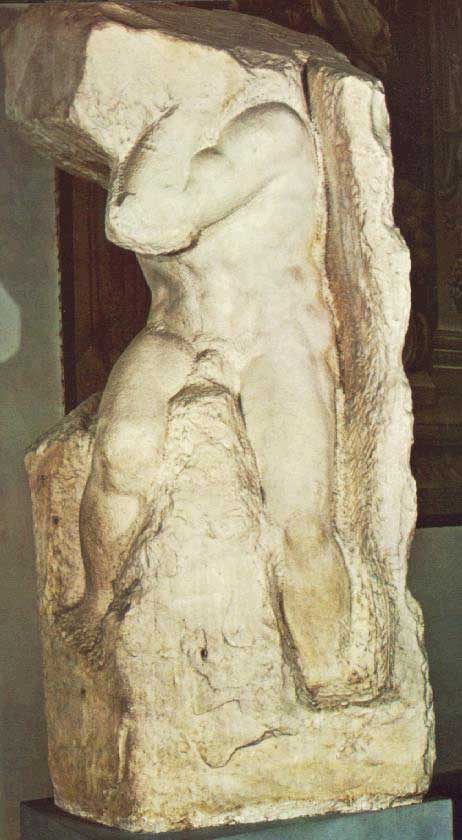the work of his hands -iii. the image of christ
The material does not easily surrender itself to the sculptor. It is neccessary to conquer it every day until you understand it. Only then does the material reveal its secrets, its intimate voices, its mysteries. This is not a knowledge that comes from chemistry or geology. This is not enough. It is neccessary to know the material through love, before you can master it, taking advantage of all its aesthetic possibilities. Each stone has its own composition, its own hardness, its colour, its veins, its spots, and all this requires the use of different tools."Now what is sculpture?" demanded Bertoldo [speaking
to Michelangelo] in a mentor's tone. "It is the art which, by removing all that is superfluous from the material under treatment, reduces it to that form designed in the artist's mind."
-Irving Stone, The Agony and the Ecstasy
God holds His face a few inches from the stone of the self, and, in the bright and steady light of His love, He inspects us, noting the composition, its hardness, its colour, its veins, its spots, to know exactly which tool to use and precisely where to use it.
The way God works is similar to the way Michelangelo worked, as he used different tools to achieve different results. He used the hammer, which was his primary tool, along with a variety of pointed chisels that he used to shape the block. Some chisels had serrated edges. Others were flat. Each had its own role in shaping the marble, its own special use, however slight. He also had an assortment of rasps and abrasives.
The tools of a torturer. Or so it seems.
From the perspective of the onlooker, when the artist begins his work, every blow from the hammer seems a random act of violence, every bit of the chisel, a senseless act of vandalism.
From the perspective of the slab, the blows it receives are even more difficult to comprehend. Who can blame the marble for not being able to make sense of what is happening to it? Who can blame it for its questions and its reactions? The waste seems so senseless. What purpose did it serve? What good did it accomplish? And who is the strange being that wields such a cruel hammer in one hand and such a cold chisel in the other?
In an untitled poem Michelangelo explained the process.
With chiselled touch
The stone unhewn and cold
Becomes a living mould.
The more the marble wastes,
The more the statue grows.
It is a confusing time for the work-in-progress. It is neither stone nor art, at home neither in the quarry nor the gallery. But bit by bit the slab grows smaller, and day by day its shape changes. Until one day, a shaft of sun angles from an open shutter to reveal the nature of the shape that is emerging. The features are unmistakable. It is rough-hewn but rounded. A head of some sort, a human head it seems. Within that head are the etched beginnings of eyes. Below them and between them, a jagged escarpment that appears to be a nose. And an elongated protrusion that, by its placement, can only be a mouth.
Day by day the work continues. The more the marble wastes, the more the statue grows. The eyes are now distinct. Later, they will be deepened. Later still, they will be polished until peace shines from within them. The mouth is mysterious now. Later, the curvature of kindness will shape its lips. The work is now more sculpture than a slab. The stone sees that something eternal is emerging from its embedded resistance. More and more it yields to the beauty it is becoming.
To the beauty it is becoming.
We are the work of His hands, you and I. Which is to say, we are roughly quarried stone on our way to becoming the magnum opus of God, the "great work" of His life. The work He thinks of, dreams of. The work He frets over, obessesses over.
We are a masterpiece in the making. And not just any masterpiece. His masterpiece. More magnificent than the Pieta.
The circumstances of our life, which God uses to craft our character, are often jarring, sometimes difficult to understand and difficult to endure. "What is required of us, "advised the poet Rilke in times like these, "is that we love the difficult and learn to deal with it. In the difficult are the friendly forces, the hands that work on us."
The hands that work on us are God's hands. And just as Jesus worked beside his Father in the creation of the world, so he lends his hands in the crafting of our charcter. Those hands are sometimes near, touching the contours of our soul. Other times they are far, searching for a different tool. All times, though, they are purposeful. Their purpose is to make us beautiful.
The beauty of Christ is what we are destined for.

"Unfinished bound slave", Michelangelo
"Yet, O LORD , you are our Father. We are the clay, you are the potter;
we are all the work of your hand." -Is. 64:8








